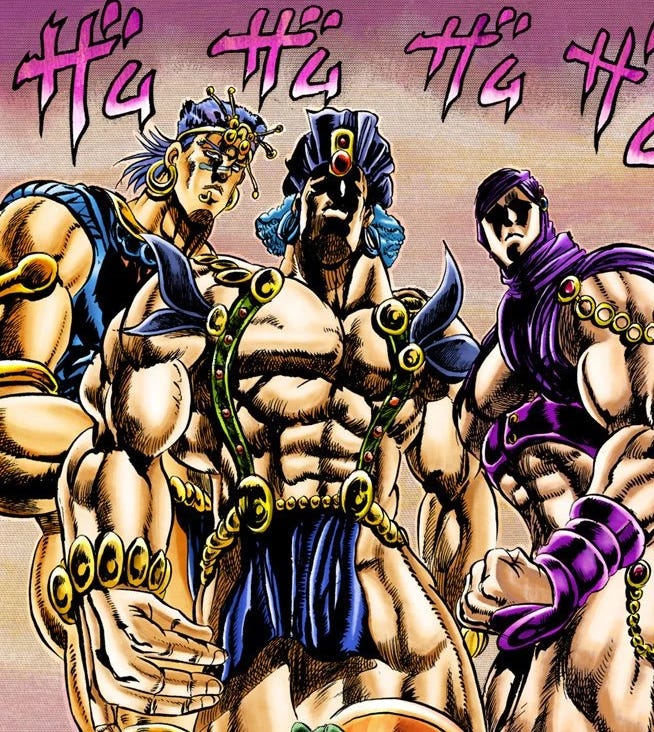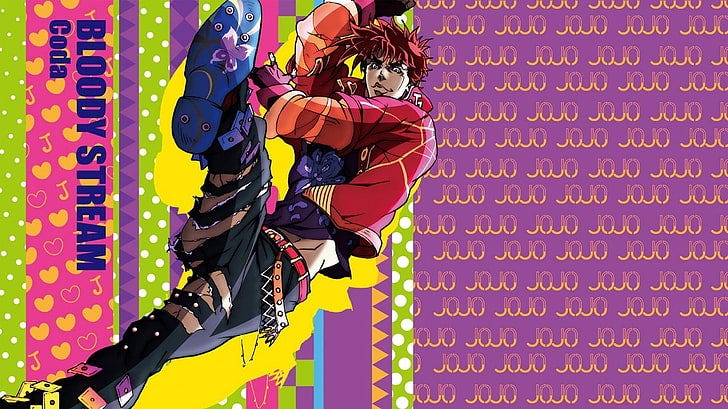Araki and Globalization in Jojo’s Bizzare Adventure

Jojo’s Bizarre Adventure: truly a strange anime series. Exciting mind games mid-battles, an aesthetic of bright colors and Grecian poses, and combined with a captivating plot, this series pulled me into Hirohiko Araki’s work. Part II: Battle Tendency was one of my favourite seasons of the anime. A large part is thanks to the villains: the Pillar Men. They are full of religious syncretism and a global cultural relevance that is unique to the anime genre.
Araki made the Pillar Men globalized villains for his show about Japanese-English muscle men fighting evil around the world, and that is awesome.

0.A Quick Background:
For those who haven’t seen the anime or read the manga, a recap: Victorian gentleman type Jonathan Joestar is lost at sea. His grandson, Joeseph Joestar, is awakened to his destiny by the arrival of mysterious vampires and stone masks. Mastering his breathing based qi-esque Ripple abilities, Joseph learn to control his hamon. With his Italian best friend, they go to battle the Aztec dieties / super ancient aliens known as the Pillar Men across the globe.
So why are an Italian and English-man battling these Herculean Aztec Gods? Who are the Pillar Men, and what do they represent?
The four Pillar Men we see are Santaviento (Santana, our minor fourth member of the group), Wamuu(Wham!), Esidisi (AC/DC), and Kars(the Cars). Their names are references to the Western 1970s rock bands Araki listened to. Our first link to a larger world of cultural connections?
Kars and his subordinates were a species that evolved as precursors to homo sapiens. Not only do they look like us, but are much superior to us in intelligence and strength / natural abilites. Great.
But uno reverse, they are bound by sunlight, cutting their capabilites rather considerably. Kars wished to break this curse, so he built the stone masks that would have allowed them to have sunscreen…and unlock their potential as ultimate beings. The rest of the species was against this, so Kars broke them. He and the Pillar Men group were the only survivors.
They are found in a Aztec monument when the series begins, but it is revealed they travelled the world seeking a power source for their masks. Rome, Egypt, China; nowhere and no time was safe. They were a global force to be reckoned. Perfect villain dieties for the 21st century audience.

1.Scientific SuperStrength: Araki and Science
Opposed to being formed from chaos like the Greco-Roman dieties or gods of creation, these dieties have an evolutionary basis. Their powers are organic. Kars stone shell is created through organic foam bubbling to the skins surface to cool him under intense heat. His blades are made of his own bone. Araki imbued his villains with powers of this world, theoretically speaking.
Other abilites in the series are explained through this natural-supernatural origin. The stone masks to turn people into vampires? Acupuncture to unlock inner biological potential. Cesar (Italian best friend) can shoot weaponized bubbles? A result of a ancient breathing technique to harness the bodies inner power. Science rather than mysticism is the game.
In the aftermath of World War II, during the 1960s-80s, Japan was both reeling from its destruction at the hands of the atomic bomb and defeat in World War II, but also embracing advancement and modernization. Astro-Boy was created in response to the trauama and Westernization of Japan. He uses his nuclear heart to lighten a path of hope for the future, rather than using it for conquest and evil. With the help of technology and superpowers, children could help society and science would become sacred.
Akira had a child using technology and superpowers, but in a complete opposite direction from Astroboy. Through his transformation into a “mutating biomass of rage”, humanity was destroyed. Pillar Men fit more into this genre development. They are a threat to humanity, and not a supernatural one — rather they are from the organic world, a top predator, making them all the more real.

2. Cultural chimeras
“That’s why I based the four of their appearances (including Saviento) on Roman statues, Egyptian sphinxes, and Japanese nio statues — to give them a strange physical beauty as godlike figures in organic form.” — Araki,
To make the threat more global (read: exstitential) the Pillar Men combine elements from different features like a cultural Voltron. Elements are combined not only in sight, but through sound and memory too.
Icarus flew too close to the sun in ancient Greek mythology andKars perished after being shot into the vacuum of space; both figures were victims of their arrogance and suffered a celestial fate. When the Pillar Men remerge from stone, and in many appearances after, they hold a Greco-Roman pose. Renaissance sculpture calls this contrapposto.
Central American and Aztec aesthetics are brought into play. Sound effects, like wind flutes and chanting, create a emotional register for a viewer. The characters are associated by the audience to be Aztec, or Central American or at least very ancient, through these sounds. In the anime, Western ‘trap’ style beats are brought into the soundscape, creating a otherworldly atmosphere formed of past and present sounds.
3. The Core Japaneseness Principle
Japaneseness is important within this syncratic framework. The Pillar Men are represented in a social hierarchy dictated by the size of their horns and vertical representation on a archaeological totem. But where does this derive from? Shinto oni. The more horns an oni has, the stronger it is compared to others. The most powerful oni, Shuten-doji, had a five-horned head.
The tension between Kars and Whamu in Chapter 66 of the manga is a good example of this. Kars is attacked when he steps in Whamu’s shadow, as the latter is ‘protective’ of it. Apart from being a personality quirk, this action demonstrates a hierarchical tension between the two. Kars also attacked his matriarch in ancient times to usurp her. These are Japanese notions of society and mythology.
A bit of a stretch, Buddhism potentially makes an appearance in the Pillar Men appearance. Those vampire fangs are not only a reference to the European vampire, but also can be interpreted as the Buddhist fangs that scare away evil. In a way, Kars could be an Anti-Buddha: he is from outside this world, he seeks enlightenment and rebirth, but at the cost of other lower lifeforms.
4.Beyond the Anime
Miyazaki once stated that Japanese culture ‘fuses diverse cultural elements into something new’. The modern world requires a fantasy to represent it’s diverse and extensive religious traditions. Araki mixed and matched different themes to create a novel antagonist, one centred on global traditions and Japanese ones.
The Pillar Men have gone beyond the confines of their series. In the fandom, memes and video edits abound are made. Other communities aren’t safe from the Pillar Men either. In the process, the Pillar Men are ritualized; they have greater meaning ascribed to them outside their original context. Engaging with a global audience is a testament to their creation. In a way, the Pillar Men are a storehouse of religious concepts for a global audience.
